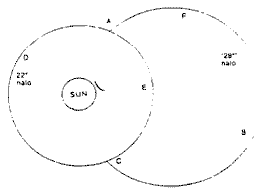 |
Science Frontiers ONLINE No. 94: Jul-Aug 1994 |
|
|
An offset solar halo of 28°
Anomalists should not perfunctorily dismiss unusual halo phenomena as trivial and/or boring. The laws of atmospheric optics have no room for the phenomenon described below. It is just as anomalous as ball lightning, although perhaps not as exciting!
 The 22° halo on the left is common and nonanomalous. However, optical theory has no room for the offset 28° halo on the right. |
"A 22° halo [the well-explained type] was very prominent, with the sector DCE being exceptionally bright and the colours quite strong. On the right-hand side of this, a larger but fainter halo could easily be seen, having a diameter of about 28° (see figure). It was white in colour. The sector CB was the brightest, sector BF not so bright but easily seen, but the sector AF could be seen only with difficulty. The halo was not seen to penetrate the 22° halo at either points A and C and so it could not be stated positively that the halo would have passed through the Sun, although it looked as though this would have been the case. The centre of the 28° halo had an altitude approximately the same as that of the Sun. The phenomenon lasted for about 20 minutes, although the 22° halo lasted for at least another hour."
(Miles, Howard; "An Unusual Solar Halo," British Astronomical Association, Journal, vol. 103, 1993.)
Reference. Chapter GEH in the catalog Rare Halos, Mirages describes a large variety of anomalous halos. Ordering information here.